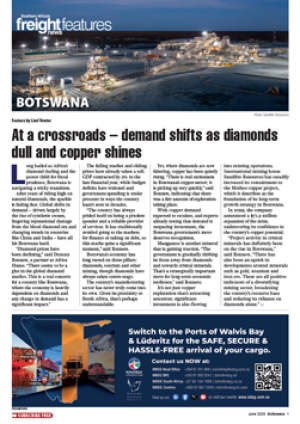New Maersk SA MD brings impressive global pedigree EVER SINCE a ten week stint in South Africa in 1997 when he played a key role in setting up the local Maersk network, new Maersk South Africa managing director Flemming Dalgaard has nurtured a keen desire to return to the country which he believes is brimming with opportunities. And his impressive track record, which has spanned the globe, could not equip him more fully for the job at hand. After completing the Maersk management trainee education in 1986-1988, he took up his first overseas posting in Dubai, to be followed by stints in Denmark, East Africa, Hungary, South Africa, Germany, and most recently China. His close bond with the African continent began in 1991 when he was posted to East Africa and was responsible for setting up the Maersk organisation in Kenya. His career has continued to maintain strong links with the African market ever since. In 1997 he was seconded to South Africa for 10 weeks, working with Niels Strand Nielsen to set up the local structure of Maersk South Africa. At that stage Kien Hung line had closed down its Europe service following the loss of the Volkswagen contract and Maersk Line, which was at the time slot-chartering with Kien Hung from Europe, decided to set up a fully fledged liner network of its own. “Those ten weeks really gave me the idea that if I ever had the opportunity I would definitely like to come back and live here,” says Dalgaard. He subsequently spent two years in Germany, before returning to head office in Denmark where he was appointed director in charge of the line’s African network, largely involved in strategic planning. It was a critical time - just three months after the purchase of Safmarine - and Dalgaard was intimately involved in Maersk’s strategic decisions at the time, one of which was joining the SAECS service. From his early perspective Dalgaard is keen to develop South Africa’s strategic potential, but he concedes that improved port productivity is crucial to its success. Productive port “South Africa has the potential to become the transhipment hub for southern and West Africa. It’s a unique opportunity but will only be achieved with a productive and efficient port system. There is a window of opportunity for this which will close in a few years.” From a Maersk Sealand perspective, Dalgaard sees the line continuing to look at total transport solutions from more and more inland points. “We already offer that for reefer as well as dry containers today and will continue to expand this area.” With the SAECS service’s Big Whites due to be phased out in 2005, it is expected that the SAECS consortium will deploy fully cellular ships capable of carrying an increased number of integral reefer containers. “There will be more space on these ships which means we will need to go out and find new products to fill them. In the past for example we haven’t been able to send citrus to certain parts of the world, and this will now become possible.” Dalgaard believes South Africa is in an enviable position, with its seasons directly juxtaposed to the European and North American markets. “This provides enormous opportunities for reefer exports, and new technology such as controlled atmosphere is now making it easier to export a lot of fruit that has not been seafreight-friendly in the past.” Based at head office in Cape Town, Dalgaard takes over from Peter Ehrenreich who has taken up a senior executive position with Safmarine in Singapore. Flemming Dalgaard - South Africa has the potential to become the transhipment hub for southern and West Africa.
